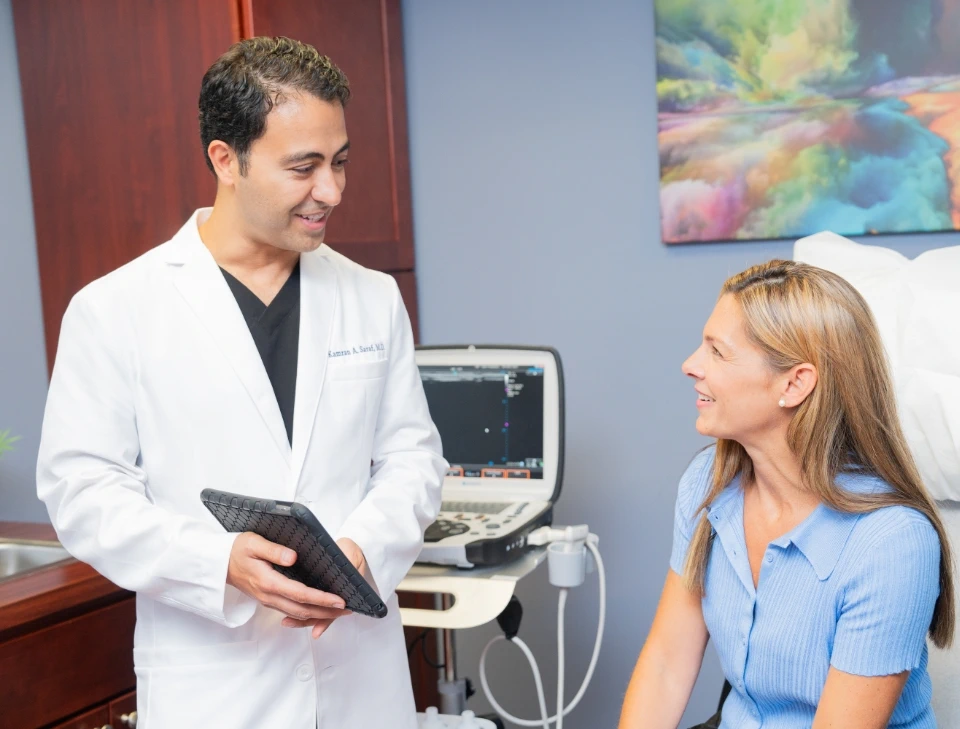Today, several minimally invasive treatment options are available for varicose veins today. Here are the advantages and disadvantages of each treatment option.
The best varicose vein treatment on LI: VenaSeal
VenaSeal is the most advanced minimally invasive treatment option available at modern varicose vein clinics today. This procedure involves accessing the defective vein through a catheter, and using this to deliver drops of medicated glue throughout the vein. The glue hardens and the vein instantly seals off. VenaSeal has several advantages:
It does not need a prior numbing injection, like other minimally invasive procedures because it is well tolerated.

You do not need to wear compression stockings after the procedure.
However, VenaSeal is a fairly new procedure, so long term evidence on its efficacy does not exist. For this reason, it may not be covered by all insurance carriers.
The most popular choice for varicose vein treatment: Radiofrequency ablation
Radiofrequency ablation has been around for a number of years, and there is robust, long term evidence for its efficacy. Insurance carriers usually cover the cost of radiofrequency ablation. For this reason, it is the most commonly performed procedure by vein specialists for varicose veins.

This procedure needs a prior numbing injection. A thin catheter, inserted into the vein, is attached to a radiofrequency device which delivers heat into the vein. The heat causes the vein walls to ‘melt’ and eventually scar, which seals off the vein. During the scarring process, which can take a couple of weeks, the vein must stay shut. Therefore, you will need to wear compression stockings for two to three weeks after the procedure.
Treatment for residuals: Sclerotherapy or Varithena
The above methods usually shut down the largest defective veins. After they are employed, you may still have visible varicose veins and spider veins. These are treated by direct injections. In sclerotherapy, a liquid solution called sclerosant is injected into the veins. This solution makes the vein walls stick together. Sclerosant does not spread out much, and this is only suitable for tiny spider veins. Varithena, on the other hand, uses a foam based sclerosant. This can spread out more, and is used for larger spider veins and small varicose veins.
Reasonable alternatives: Endovenous Laser ablation and ClariVein
These are often used as alternate techniques to radiofrequency ablation and VenaSeal. Endovenous laser ablation is very similar to radiofrequency ablation except that laser energy is used as a source of heat. This generates higher temperatures, and has greater intensity, which is why it may cause slightly more procedural discomfort. Vein specialists who have tried and tested radiofrequency ablation generally prefer this to laser treatment.
ClariVein is another cutting edge technique that does not need a numbing injection. It does, however, need special equipment – a catheter that is fitted with a rotating head. This head is used to disperse sclerosant solution throughout the defective vein, in all directions. Like most other procedures, the ClariVein procedure also requires a healing period to allow the vein to scar and seal off.
Ambulatory phlebectomy: possibly the last choice
Vein doctors prefer to use ambulatory phlebectomy only for severe cases, or in rare instances where minimally invasive treatments have not worked. This is generally reserved for bulging varicose veins, that project above the skin surface. A numbing injection is necessary for this procedure. Slit like incisions are made on the skin surface, and the vein is physically removed in multiple small segments. Since incisions are needed, you will need stitches and may possibly develop a scar, which should heal over a period of time. You will need a few weeks to recover from this procedure, and will need to wear compression stockings during this time to minimize swelling and bruising.
Don’t make the decision yourself – let a varicose vein doctor help you decide!
With so many options available, it may be difficult to decide on the right treatment plan for you.
At the Vein Treatment Clinic, you can consult with one of our two vein specialists:
- Dr. Caroline Novak: A certified diplomate in vein medicine, with additional expertise in the field of vascular imaging
- Dr. Kamran Saraf: A trained surgeon and anesthesiologist, known for his excellent treatment outcomes.
Our vein doctors are now consulting from two locations in Long Island. On the South shore, our vein Clinic in located in West Islip, bordering Suffolk County. On the North Shore, our vein doctors are seeing patients in Jericho. You can schedule a consultation with our vein doctors at either of these locations by booking an appointment online, or calling 631-919-4958 (North) or 631-407-2881 (South).
To learn more about the different options for spider and varicose vein treatment, please visit https://www.veintreatmentclinic.com/vein-treatment/. Our accredited vein centers offer all of the latest technology, and our accomplished and compassionate vein experts will create a custom treatment plan tailored to your individual needs. We have locations in New York, Long Island, New Jersey, and California.
Don’t ignore your symptoms
At Vein Treatment Clinic, we’re proud to serve Long Island with expert vein doctors and convenient clinics across the region.
Whether you’re in Jericho, West Islip, or Port Jefferson, you’ll find advanced care for spider veins, varicose veins, and chronic venous insufficiency at our Long Island vein centers.
Patients trust our Ivy League–trained, board-certified specialists for minimally invasive treatments that improve circulation, relieve pain, and restore confidence. On Long Island, our team includes Dr. Zalekha Shair and Dr. Gulshan Sethi, two highly respected vein experts committed to personalized patient care.
Book your consultation today at the Long Island clinic nearest you.







